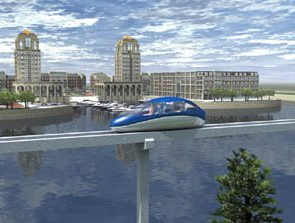New Transportation Technology
When can new transportation technology be implemented

The social demand of modern technology has driven people into a desire for instant transportation. Trains, cars, and jet planes are too slow for instant transportation transfer to satisfy society’s desire. Teleportation has been on the horizon since the television show: “Star Trek”. “Star Trek” first aired in the 1960s. Although technology has taken phenomenal leaps since the 1960s, transportation is fundamentally the same. Nearly all automobile advances are related to computerization and communications, the mode as automobile transportation is the same. With all the technological advances, the modes of transportation have remained the same for 100 years.
Political climate
When will a new mode of transportation be brought to the market? The high-tech industry is in relentless war to impose driverless cars onto the public. With the thousands of satellites and satellite arrays in orbit, the political ‘green’ mantra is total incoherence to what sustainability is. Sustainability adheres to nature rather than technology dependence. Green politics misrepresents the fundamentals of common sense. Although every aspect of automobile centric land-use design is unsustainable, policies of the green agenda push to proliferate the totally unsustainable current methods of transportation.
Bad habits are only stopped by not doing them. Alternatives provide a way to successful change. Where is an alternative in transportation? It doesn’t exist. Big tech is actively substituting change for its single purpose of profitability. Marketing terms completely lack any ability to provide sustainability. Corporate and their government lobbyists created the 'green' agenda as a marketing tool; strictly as a means towards higher sales profitability. Public targeting of 'green' marketing is based on feelings of desiring good intent but is susceptible to failed policies which fall short of good-intended desires. The consequence of such dictatorship legislating, is that it often causes unintended but, catastrophic problems. The gullibility of the public masses inundated with such a pervasive poisoning agenda is tragic.
This website is about transportation, and legislative dictates of green politics have seeped into transportation. New technology transit systems can only be implemented when new technology systems have funding available to build it. The viability of new and innovative transportation technology poses a threat to the status-quo of embedded political procedure. Many inventive and incredibly good transportation technologies are summoned to oblivion by political will at the command of established financial lobbying interests.
PRT systems
Throughout the late 1990s and early 2000s, one website led PRT technology system technology information. It monitored more than 100 urban transport system innovations from around the world. Some of the technologies were operational, others were in the prototype/testing stage, and others were conceptual with available planning info. Many of the technologies featured autonomous vehicles that provided door-to-door service at higher speeds and lower costs. Although the website is still online, the site was abandoned around 2016. Faculty.washington.edu/jbs/trans still hosts the site.
A website dedicated to existing transit systems is Transitwiki. A generalized transit technology page. At its PRT page, it merely provides a brief explanation about the concept of what PRT is.
It says: Though they operate over fixed routes they can bypass stations and can be part of a denser network of stops that can provide more convenient locations for passenger access than traditional fixed rail systems. Due to their smaller vehicle size, typically carrying 4 or 6 passengers though larger capacity vehicle can be used, the stations can be smaller and less expensive to build. Though they are slower moving and carry fewer passengers per car, because they can operate on reduced headways, over larger areas, and at higher average speeds they are capable of passenger throughputs similar to other rail modes.
Advantages and Disadvantages
Compared to steel wheeled and diesel powered transit vehicles, PRT are quieter and more energy efficient since they operate on rubber tires and are powered by electricity. The are also potentially safer since the vehicles are lighter than LRTs and run on dedicated guideways. They also take up less land for stations and right-of-way though this may be less so with greater network coverage. On the down side, PRT systems require a larger number of vehicles than other modes which could increase maintenance and replacement costs.
The transitwiki.org website illustrates traditions of the government perspective which follows academic dogma. Realistically, the 'downside' of having large numbers of vehicles is a phenomenal advantage. The headway (distance between vehicles), with some PRT systems is remarkably short. This actually largely increases ridership capability, greatly exceeding load capacity of freeways full of cars. Additionally, as a point of fact, not all PRT systems are rubber tire technology. The majority of viable PRT system technologies use magnetic levitation (maglev) technology.
The biggest negative issue with these new transit system technologies; is that as of yet, these systems haven’t been implemented into service. Therefore, to governments and academia, they don’t exist.
The sad story of PRT
This article in treehugger.com is an interesting history of Taxi 2000. The article has pictures of an era that provided innovative concepts that could have been a major transportation influence for the 2000s.
What happened to PRT? Here is one of the best articles that provides information about the PRT industry; from The Verge.
To quote Adi Robertson from the article, PRT was “a public transit revolution that never was.”
Since PRT isn’t going to happen anytime soon, how about replacing streetcars with Group Rapid Transit (GRT)? There are a few transit technologies that have been around for over thirty-five years; still actively working to implement their technology. One such technology is CyberTran.
Why not PRT?
The many opponents and critics of the new technology transit industry represent government. Derogatory articles, such as a 2014 article in Bloomberg present a risk adverse mindset.
A question at quora.com has a couple of responses which provide general unenthusiastic considerations.
First and foremost, the general population has no idea what PRT is. Even the acronym is foreign to most people. Especially legislators who’ve never heard of PRT. To allocate billions of dollars on an unknown and unproven technology is high risk. The government is risk adverse. Lobbyists promote financial interests in ten decades of status-quo transportation tradition.
Beyond PRT is another new technology to replace trains: Hyperloop. Although a new technology, it is fundamentally train technology and incapable of serving society’s transportation needs for today. The limitations of train and airplane type technology carrying passengers from station to station, hasn't changed from the 200-year-old train single point destination technology. Hyperloop's speed capability of 700mph is faster than commercial jets, which travel from 450 mph to 600 mph. It’s not a bad technology, merely not a new mode of transportation.
One of the best explanations of PRT and GRT is that this type of transportation is dependent upon an area’s land-use design. Transit systems are dependent on transit-oriented land-use designs. One of the main reasons PRT doesn't work is the size network. Most PRT systems serve as parking lot shuttles.
Another reason for PRT’s failure is that a metropolitan transit system is dysfunctional in an automobile centric land-use design. The automobile land-use design does not accommodate transit.
Also, the infrastructure is excessively costly, especially in relation to the cost of the rights-of-ways. For a PRT system which is dependent upon its farebox as the only source of income, the cost of infrastructure exceeds its potential income. When the ROI (return on investment) exceeds any potential income; it's impossible for a PRT system to acquire a funding source to be built. Conversely, public transit systems operate on tax money, and can afford to lose exorbitant sums. As an example, it's normal for the government funded transit systems to lose 70% to 95% of dollars spent, just to maintain their public transit costs.
Are there solutions? Of course there are, however, innovation is a product of the private sector.



